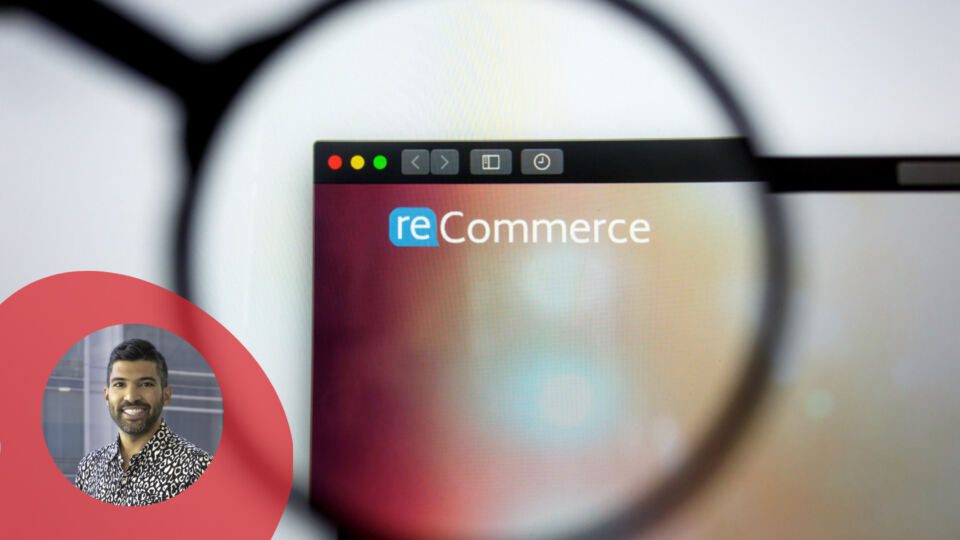As retailers have struggled to navigate changes in consumer behavior and economic uncertainty brought on by the pandemic, one area has seen continued growth: recommerce. This trend involves brands reselling previously owned products at a discount — and it’s caught on quickly. The resale market is growing 11 times faster than traditional retail and is expected to reach $84 billion by 2030, far eclipsing the predicted $40 billion market for fast fashion.
Why the strong growth, particularly during a time of economic upheaval? Recommerce checks many boxes for both consumers and businesses. Millennial and Gen Z shoppers, in particular, are prioritizing sustainability, while consumers broadly are searching for deals after tightening their wallets over the last year and a half. For brands, recommerce expands the lifecycle of existing products and supply chains. It’s an important secondary market for returned goods, helping retailers reduce waste and recover cost, especially as returns increase in step with ecommerce growth.
Here’s how brands can marry sustainability with returns optimization to get better ROI out of what they’ve already invested in — chiefly, their products.
Understanding the Resale Phenomenon
Recommerce has taken off in the clothing space in particular, driven by changes in shopper habits during the pandemic. In fact, apparel resale revenues are growing 24 times faster than retail apparel sales.
Advertisement
With people often stuck at home due to COVID-19, many have turned to their closets for new ways to earn income. Savvy shoppers now see luxury items like vintage handbags and pre-owned Gucci to be a financial investment. Meanwhile, the resurgence of vintage trends increased demand for the clothing styles of days past. As a result, online resale marketplaces like The RealReal, ThredUP and Poshmark gained many new customers throughout the past year and a half. ThredUP, which calls itself one of the largest online thrift stores, reports that 33 million consumers bought secondhand apparel for the first time in 2020.
Established players have also been planting seeds in the secondhand field, using sustainability trends to drive momentum. In April 2021, Lululemon announced a soft launch of its resale program that lets shoppers sell and buy used merchandise. The brand now offers its “Like New” resale options online and in one-third of its U.S. stores with the goal of “actively working to create a healthier future,” according to CEO Calvin McDonald.
Importantly, Lululemon has stressed quality and cleanliness, two factors other brands will have to focus on in order to reassure consumers. All traded-in items are cleaned, and anything that doesn’t meet Lululemon’s quality standards is recycled.
Levi’s marketers astutely recognized this trend during the pandemic and debuted Levi’s SecondHand in October 2020. With Levi’s 501 jeans and jean jackets immersed in recent pop culture history, the endeavor represents a perfect convergence of the brand’s loyalists, the longevity of its products and the cool factor of vintage.
And with recommerce technology startup Trove raising $77 million in funding during late August 2021, I predict we’ll see more established brands get into this game. Indeed, it’s wise to offer shoppers as many online and offline options as possible to meet them where they are in the customer journey. Recommerce also offers new relationship-building opportunities for keeping customers updated about a recent transaction, whether that means the e-delivery of gift cards for resale programs, the dollar amount remaining on such an e-card, tracking the delivery of an online order or the status of a refund for a returned product.
Capitalizing on Product Lifecycle and Supply Chain
The consistent rollout of secondhand initiatives by major retailers is an opportunity to financially capitalize on a product’s full lifecycle. Also, the overall scenario rewards retailers with supply chains that are powered to work both classically (store and ecommerce purchases) and in reverse (returning items online and in stores), allowing retailers to sell their clothes as new and then again as secondhand across digital and store channels. Consider that 223 million consumers say they have or are open to shopping secondhand products.
Generally speaking, the recommerce trend makes perfect sense: Nice clothes just lightly used and highly discounted appeal to most kinds of consumers, all of which will be especially true if economic uncertainty endures. Secondhand has long been a winning concept among mom-and-pop shops around the world and has been proved out not only by Lululemon and Madewell but also fashion retailer Eileen Fisher, which has been reselling used versions of its clothes since 2009.
Recommerce captures important characteristics retailers need in order to recover from an economic slowdown. Taking advantage of a product’s full lifecycle speaks to growing customer awareness around sustainability and will always make ROI sense for retailers. And adding that sustainability brand characteristic to a CX mindset that lets shoppers engage with products at the right digital or physical juncture in their journey is an enduring combination that wins under almost any circumstance.
David Morin is Senior Director, Retail and Client Strategy at Narvar.




